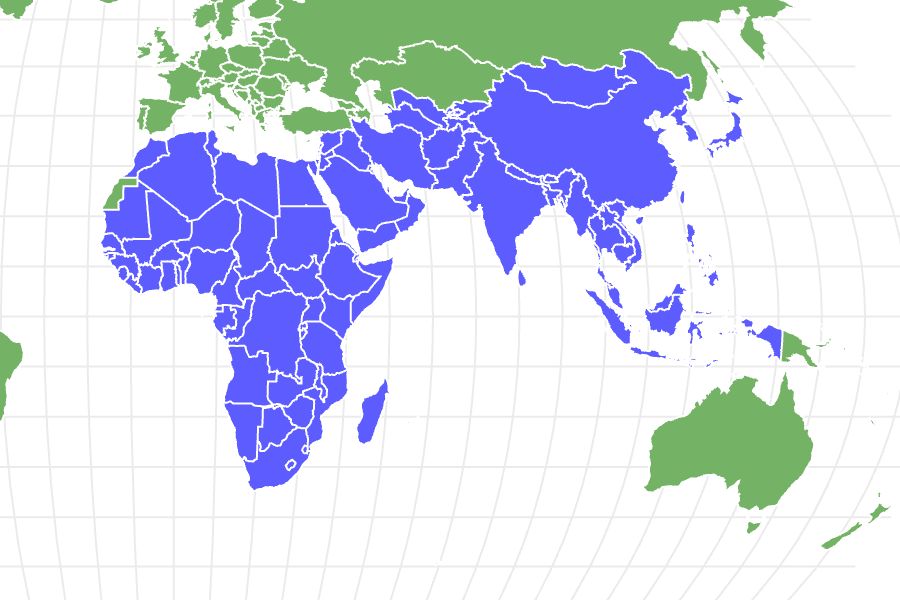Range in size from just 1 to 3 foot!
Advertisement
Mongoose Scientific Classification
- Kingdom
- Animalia
- Phylum
- Chordata
- Class
- Mammalia
- Order
- Carnivora
- Family
- Herpestidae
- Genus
- Herpestes
- Scientific Name
- Helogale Parvula
Read our Complete Guide to Classification of Animals.
Mongoose Conservation Status
Mongoose Facts
View all of the Mongoose images!
Fast and agile, the mongoose is an animal that is an adept hunter that will feed on almost anything it can catch.
The mongoose is a small, sleek animal (similar in appearance to a weasel) that roams the forests and plains of Asia and Africa. Because of its rather bold temperament, the mongoose has been the subject of human myths and stories for thousands of years. However, the life of a mongoose as a normal animal is far more complex and interesting than these myths suggest.
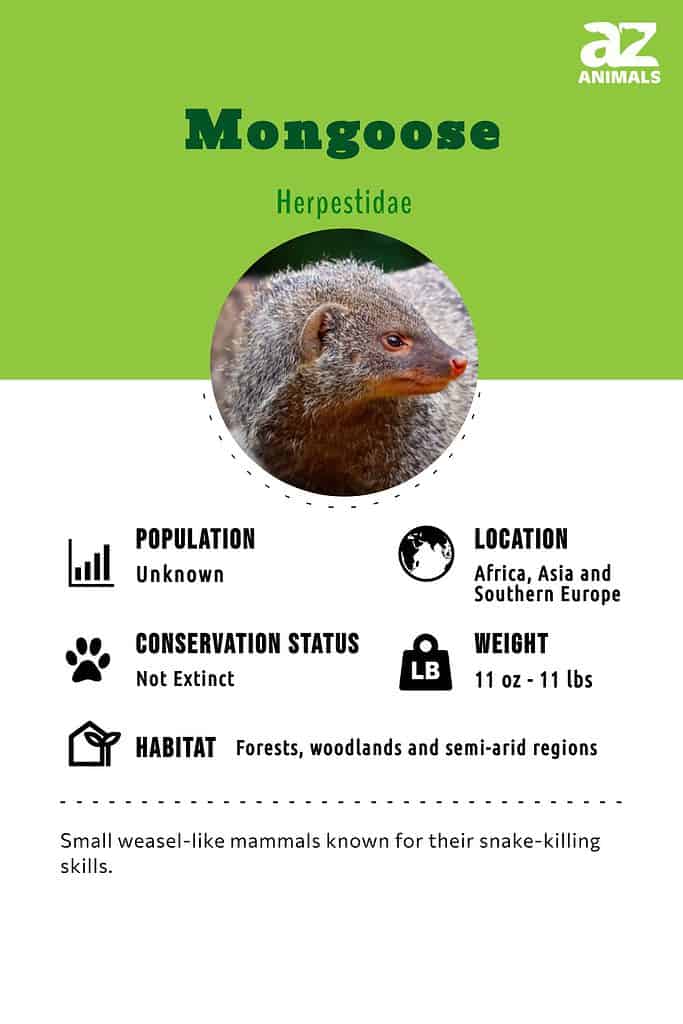
Interesting Mongoose Facts
- The mongoose is an animal that is perhaps best known for its remarkable ability to kill snakes, like the cobra. Scientists believe that they have evolved a protein that provides some degree of protection against snake venom. However, they are not completely immune from repeated snake bites.
- Ancient Egyptians would sometimes put mummified mongooses in tombs with their owners since they were common pets.
- An Indian grey mongoose called Rikki-Tikki-Tavi was immortalized in Rudyard Kipling’s The Jungle Book.
- Mongooses have horizontal-shaped pupils, similar to sheep and horses, to help avoid predators.
- In many places, mongooses are seen as an invasive species because they are a threat to native birdlife, including protected and endangered species.
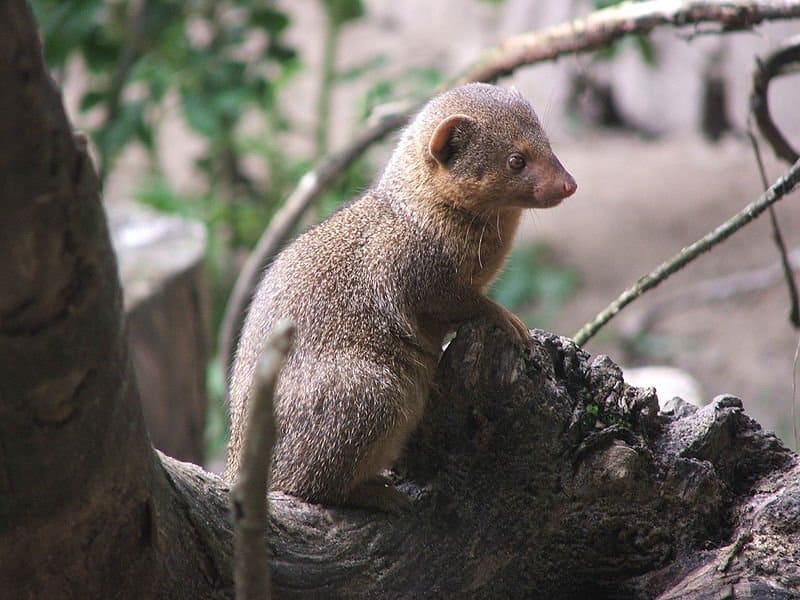
Mongooses are an example of feliformia or a cat-like carnivore.
Scientific Name
Mongoose is the colloquial, or common, the term for a group of similar species that belong exclusively to the family of Herpestidae. The scientific name derives from a Greek word for an animal that walks or creeps on all four feet. Mongooses occupy the same order — Carnivora — as cats, bears, dogs, seals, and raccoons. They are the most closely related to viverrids such as civets, genets, and linsangs. The mongoose is an animal somewhat more distantly related to the hyena, and an example of a feliformia, or a cat-like carnivore.
Evolution
It is believed that at some point early in its evolution, these animals split into two different subfamilies: the Herpestinae and Mungotinae. A third subfamily called Galidiinae was once classified with the other two. Endemic to Madagascar, Galidiinae was sometimes known as the Malagasy mongoose for its similar appearance. However, this subfamily is now classified as the family Eupleridae instead of Herpestidae.
There are around 34 mongoose species still living. This includes 23 species of Herpestinae and 11 species of Mungotinae. A few extinct species are also known from the fossil record. Mongoose species are unevenly distributed across the entire family. Some genera only have a single species in them. The genus Herpestes, however, has approximately 10 living species, including the well-known Indian grey, the Egyptian, and the crab-eating mongoose.
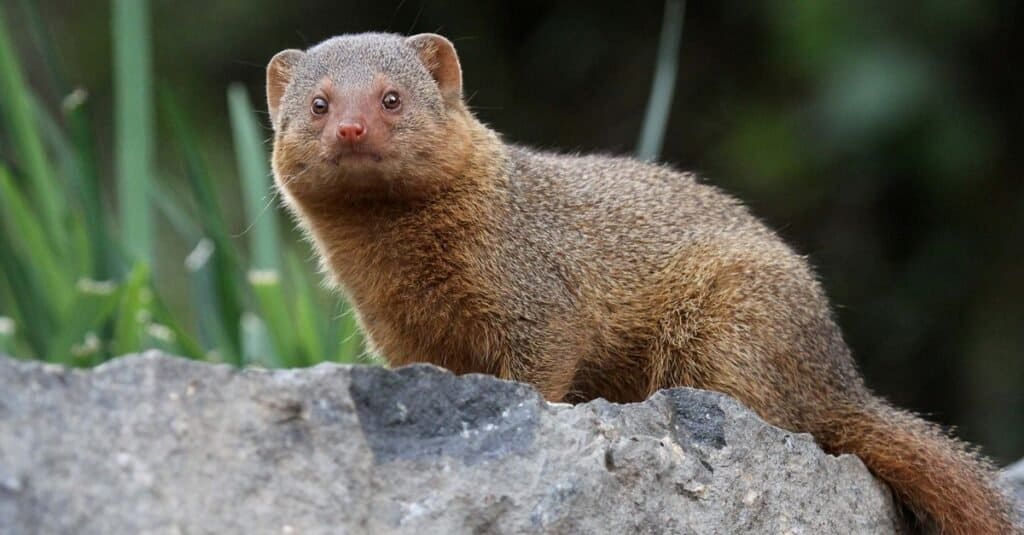
Mongooses are noted for their audacious attacks on highly venomous snakes, such as king cobras.
©steve bushman/Shutterstock.com
Appearance
These animals are typically slender creatures with elongated bodies, short legs, thin snouts, and small rounded ears. The coat color is almost always brown, gray, or even yellow, sometimes interspersed with markings or stripes. The tail may also have a unique ring pattern or coloring on it. Because of their appearance, some people mistake them for a weasel, even though their traditional range rarely overlaps.
The mongoose as an animal (not the myth!) varies in size from one species to another. Their body can range from seven inches on average for the diminutive dwarf mongoose to 25 inches on average for the massive Egyptian mongoose, while the tail adds another six to 21 inches. This makes the typical animal about the size of a house cat. The largest species can also weigh up to 11 pounds when fully grown.
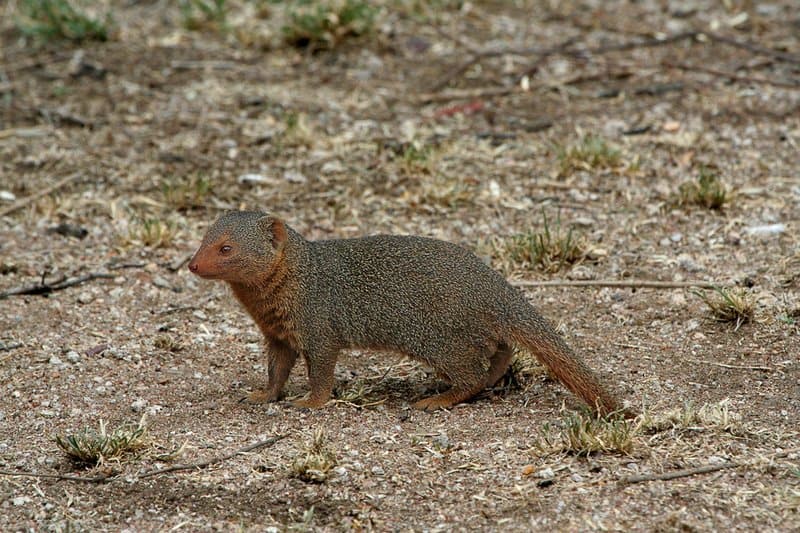
Behavior
Their sense of smell is an important part of mongoose communication. This is facilitated by the presence of large scent glands near the anus that they use to signal for mates and mark their territory. In fact, the scent gland is the primary characteristic that separates these animals from the civets, genets, and linsangs. Mongooses (the correct plural of mongoose) are animals that also rely on vocalizations to signal threats, begin courtship, and convey other critical information to other members. They have an impressive range of sounds to communicate with each other, including cries, growls, and giggling. Each sound is accompanied by a different set of behavior.
The Herpestidae family in general exhibits a wide array of social structures and behavior. While some species thrive in solitude or small clusters, other species live in colonies of up to 50 individuals. The well-known meerkat, for instance, (which was made famous by a TV show) lives in large cooperative bands with a distinct social hierarchy. Individuals are sometimes responsible for specialized tasks such as guard duty, hunting, and child protection. The colony lives or dies based on the actions of each individual member.
The particular social arrangement of a species may be related to its physical size and type of animal. The larger and more physically intimidating Egyptian mongoose is a lone hunter, while the smaller dwarf mongoose is a more social creature that staves off predators by clustering together into large groups. Alone, an individual is vulnerable. But even smaller animals can be difficult to kill when it is part of a pack.
The mongoose’s small size conceals its rather bold disposition. The creature is able to hold its ground against dangerous predators much larger or more aggressive than itself. Being able to kill snakes (even venomous species!) is only one example. These animals can also sometimes evade or bamboozle deadly predators with their impressive speed and agility. Some species can run at an average of 20 mph.
These animals are most active during the day while they hunt and socialize. They tend to spend the night in their dens asleep. Mongooses can be quite intelligent and playful, especially in social settings.
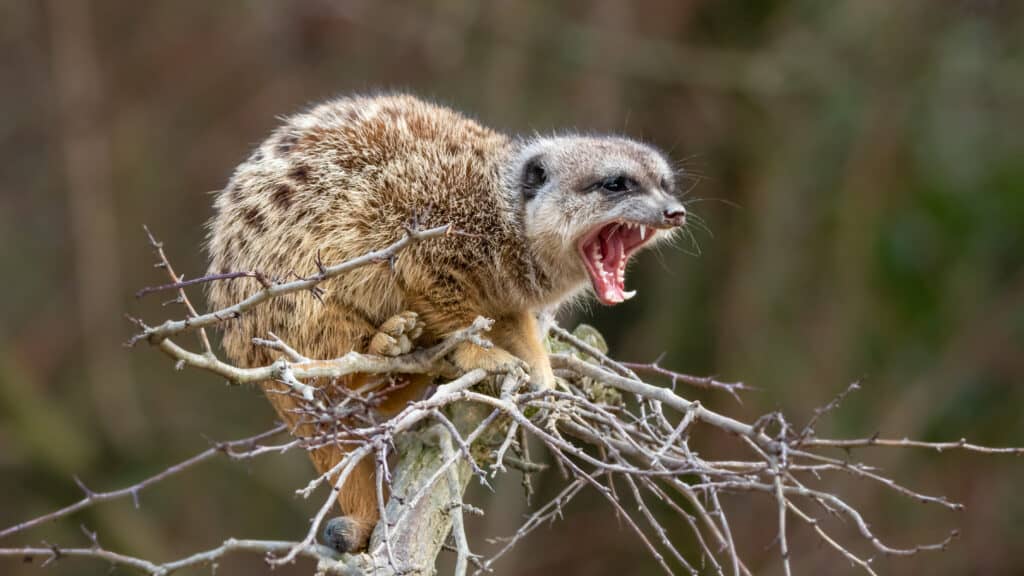
Mongooses hunt by day and sleep in their burrows at night.
©MartinJGruber/Shutterstock.com
Habitat
The mongoose is an old-world animal that thrives largely in hot or tropical areas. The largest populations can be found across sub-Saharan and Eastern Africa, including most species of Mungotinae and some species of Herpestinae. They are also fairly common throughout a long stretch of territory in southern Asia, from China to the Middle East. Other common locations include southern Iberia, Indonesia, and Borneo.
These are largely terrestrial mammals that roam the ground. They reside in a variety of different climates and habitats, including tropical forests, deserts, savannas, and grasslands. However, there are a few notable exceptions. Some species such as the crab-eating mongoose are semi-aquatic and spend a good deal of their lives in and around the water. They are quite adept at swimming with webs between their digits. Other species inhabit the trees, moving effortlessly between branches. The terrestrial mongooses, on the other hand, burrow into the ground with their big non-retractable claws. They spend much of their time within the complex system of tunnels they have created.
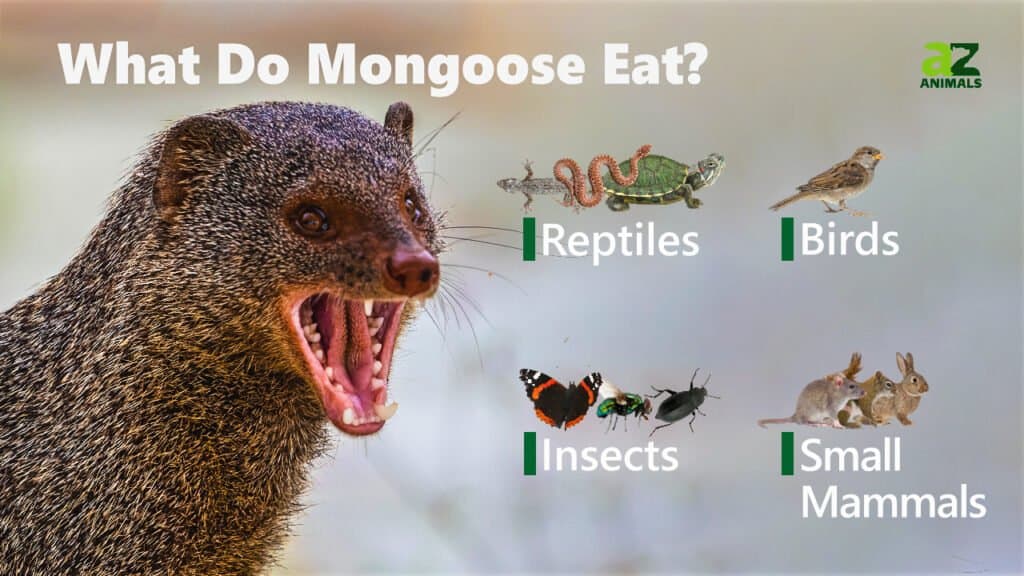
©/Shutterstock.com
Diet
These animals are opportunistic carnivores that will feed on a huge variety of different foods, whether living or dead. These may include reptiles, small birds and mammals, amphibians, insects, worms, and crabs. However, some species will supplement their diets with fruits, vegetables, roots, nuts, and seeds. If the opportunity presents itself, then the animal will steal or feed on another creature’s kill.
A clever animal, mongooses have learned the ability to smash shells, nuts, or eggs against rocks to crack them open. It can pound the object directly against a hard surface or throw the object from a distance. This tactic is passed from one generation to another, which may represent a form of transmissible culture.
The mongoose’s diverse palate can be a problem for other species, however, and they have been considered an invasive species in some areas.
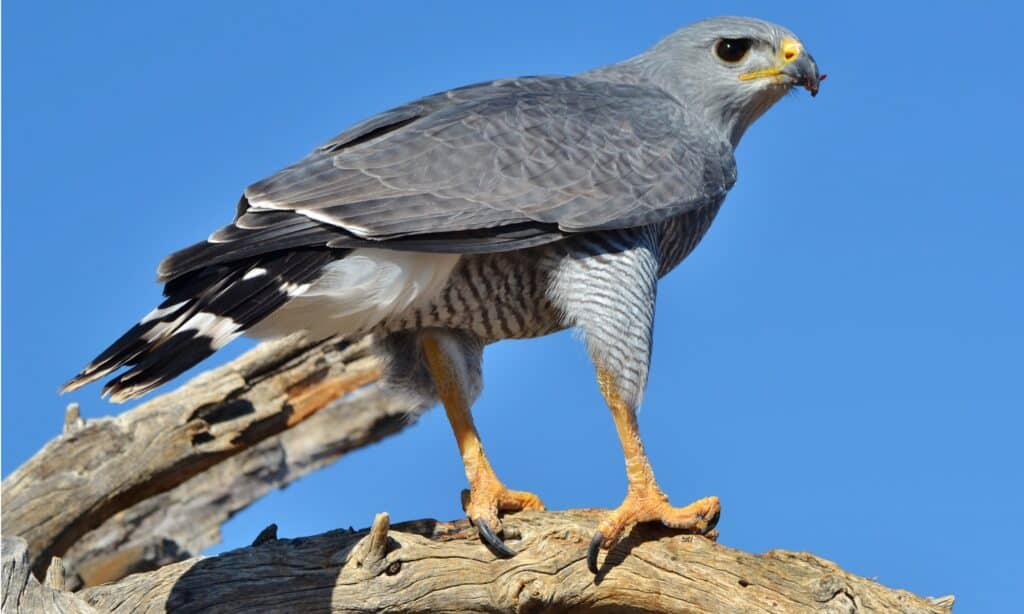
Hawks are one of only a few natural predators of the mongoose.
©iStock.com/mjf795
Predators and Threats
The Mongoose has only a few natural predators in the wild such as hawks and big cats. Larger mongooses can ward off predators through sheer physical size, but smaller species in particular are vulnerable to predation from large carnivores. The mongoose is also sometimes threatened by venomous snakes, but thanks to its agility and speed, the mongoose is more than a match for the fearsome reptile. Its sheer adaptability has enabled it to thrive across many different geographical regions around Asia and Africa. However, some types of mongooses are currently declining due to habitat loss from human encroachment. They require ample space for burrows and social arrangements.
In the 19th and 20th centuries, human settlers introduced mongooses around the globe — particularly to several oceanic islands such as Hawaii — to help with pest control on plantations and farms. Although mongooses rarely succeeded in this task, it did have the unintended consequence of driving much of the local wildlife — including many unique bird species — to the brink of extinction. For this reason, mongooses are considered to be one of the top invasive species in the world, and some efforts have been made to cull or limit mongoose populations in non-indigenous areas.
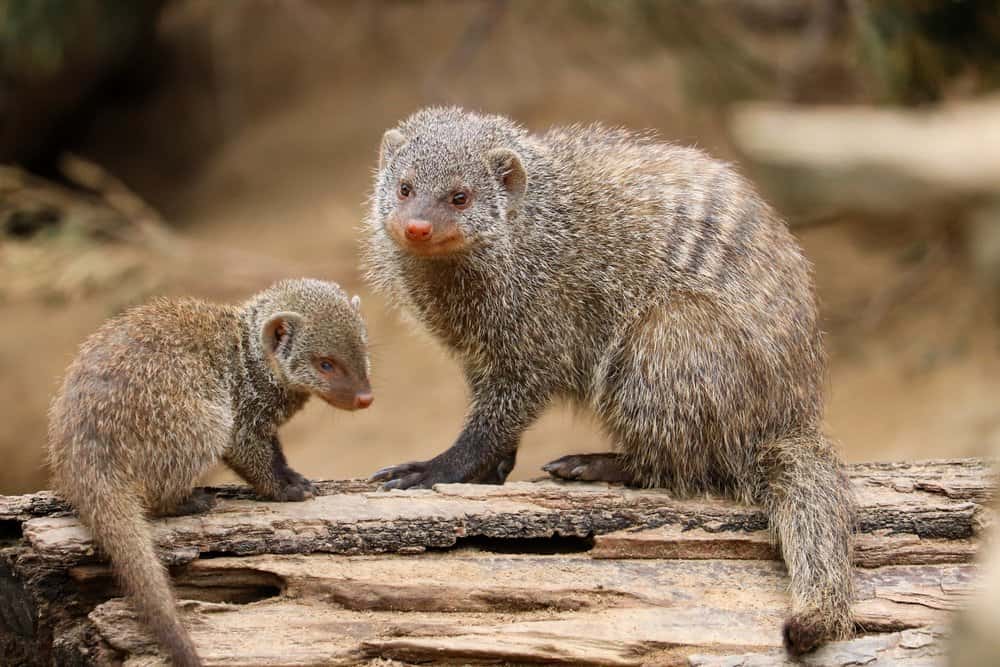
Mongooses give birth to litters of between one and six pups.
©Cassidy Te/Shutterstock.com
Reproduction, Babies, and Lifespan
Mongoose reproduction varies widely between species since it is often a reflection of their social structure. Solitary mongooses only meet up at regular intervals to reproduce, usually once a year. One or both parents may raise the young pups. Large colonies, on the other hand, tend to have a dominant member of the pack with almost exclusive breeding rights to several females — or sometimes there is a single male-female dominant pair.
Once mating is completed, the female will give birth a few months after conception. She can give birth to a litter of anywhere between one and six pups at a time. The mongoose pups tend to grow up relatively quickly. After they are weaned, the pups will remain dependent on the parent(s) for another several months. It can take between six months and two years for a pup to become fully mature.
Among more social mongoose species, pups are introduced into the colony from an early age. When foraging, several members will stay behind to protect the young. In some colonies, a pup will choose a specific adult to provide regular sustenance and attention. Individuals may even form lifelong bonds with family and/or fellow members of the colony or pack.
Lifespan depends greatly on the species, but a typical mongoose can live around 10 years in the wild and perhaps twice that in captivity.
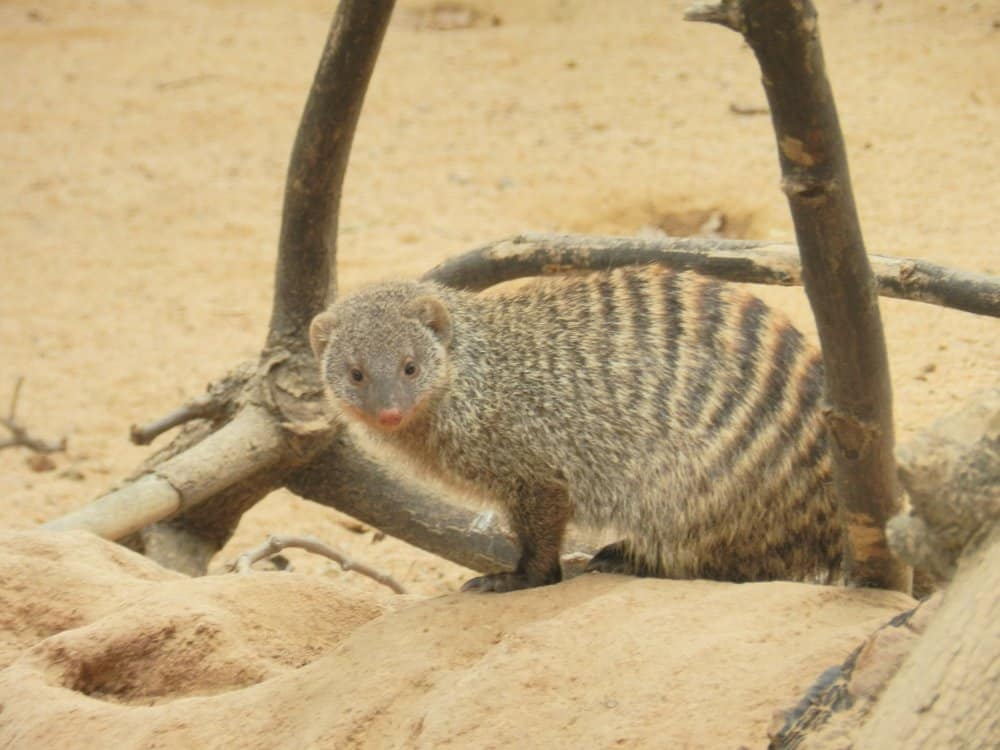
While actual population numbers are unknown – the mongoose species appear to be in robust health.
©Millie Bond – Copyright A-Z Animals
Population
Although precise population numbers are difficult to estimate, many Mongoose species across the globe appear to be in robust health. The Indian grey mongoose is perhaps the most widespread species. It is commonly found throughout the Indian subcontinent and southern Iran in a single unbroken range.
According to the International Union for the Conservation of Nature (IUCN) Red List of threatened species, the Liberian mongoose is the only species that qualifies for vulnerable status, while several other types of mongoose are near threatened. However, the Malagasy mongoose, though not a true mongoose, is under threat in its native habitat, since several species have fallen to endangered status. Habitat loss will need to be halted or reversed for some species to rebound again to their former levels.
Species
Herpestidae
- Common Slender Mongoose – Also known as the black-tailed mongoose, this common species is native to sub-Saharan Africa.
- Cape Gray Mongoose – These little mongooses are often seen darting across the roads of southern Africa. They stand on their hind legs like meerkats.
- Indian Gray Mongoose – Native to India and West Asia, the Indian Gray inhabits open forests, scrublands, and cultivated fields close to human habitation.
- Java Mongoose – Native to Southeast Asia, the Java mongoose has a creamy sepia and rich tawny brown coat.
- Yellow Mongoose – This mongoose is native to Asia and is known for its yellowish coat.
- White-tailed Mongoose – One of the largest members of the mongoose family – the white-tailed mongoose can be found in most of Africa south of the Sahara and in the southern portion of the Arabian Peninsula.
- Long-nosed Mongoose – This is another of the African mongooses – occupying most of Africa south of the Sahara and in the southern portion of the Arabian Peninsula.
- Selous Mongoose – The only member of the genus Paracynictis, the Selous mongoose is native to southern Africa.
- Bushy-tailed Mongoose – Known for its bushy tail, this mongoose is found in central Africa – from Kenya to central Mozambique.
- Meller’s Mongoose – Native to the savannas and woodlands of southeastern Africa – this little brown mongoose loves to eat termites.
- Egyptian Mongoose– This largest mongoose lives in upper Africa including Egypt.
- Crab-eating Mongoose – This species likes to hunt along river banks and bodies of water where they dine on crabs, fish, frogs, snails, birds, rodents, insects, and reptiles. They can be found in the eastern Indian subcontinent, southern China, southeastern Asia, and Taiwan.
Mungotinae
- Ringed Mongoose – Also called the banded mongoose, this species lives in the savannas and grasslands of southern Africa. They are brown with white bands across their backs and feed mostly on beetles and millipeeds.
- Gambian Mongoose – This very vocal mongoose lives in groups as large as 40 in the Guinean forest-savanna mosaic from Gambia to Nigeria.
- Poursargues Mongoose – Also known as the African tropical savanna mongoose, this species in native to central Africa. Little is known about its distribution and ecology.
- Liberian Mongoose – This social mongoose is native to Liberia and the Ivory Coast and is closely related to the ringed or banded mongoose.
- Ethiopian Dwarf Mongoose – Also known as the desert dwarf mongoose, this little animal will send out warning calls to its clan if danger is present. They are native to east Africa – mostly Ethiopia, Kenya and Somalia.
- Common Dwarf Mongoose – The smallest African carnivore, this little mongoose is extremely social and territorial. Common dwarf mongooses can be found in Angola, northern Nambia,KwaZulu-Natal in South Africa, Zambia and East Africa.
- Kusimanse Mongoose – A smaller mongoose, the Kusimanse is found in the west African countries of Ghana, Ivory Coast, Benin, Liberia and Sierra Leone. It prefers forests near water instead of grasslands that other mongoose inhabit.
- Meerkat – Probably the most famous mongoose of all is the adorable meerkat! Native to south Africa, these highly intelligent creatures use complex coordinated behavior like chimps, dolphins and humans!
Similar Animals
View all 164 animals that start with MMongoose FAQs (Frequently Asked Questions)
What is the plural of mongoose?
The plural form of mongoose is simply mongooses, not mongeese as it’s sometimes assumed to be.
Are Mongooses carnivores, herbivores, or omnivores?
While certain types of mongoose will supplement their diet with vegetation, such as nuts or fruit, mongooses are generally carnivorous creatures who will eat a range of other animals – including birds, reptiles, insects, crabs, and even small mammals.
Are mongooses dangerous?
Mongooses are not a direct threat to humans, but they may fight back if threatened or startled. For this reason, wild mongooses should be approached with caution.
Can a mongoose be kept as a pet?
Although mongooses exhibit compassion and intelligence (they can even be taught to do tricks), they often make for poor pets. Unless socialized from an early age, they are completely unsuitable for a domestic setting and may exhibit destructive behavior. Due to national laws and the challenge of rearing them, it would be difficult to even obtain one. Many countries also prevent people from importing them from elsewhere in the world. Therefore, it’s very rare for people to keep a mongoose as a pet and not recommended.
However, they were believed to be a common pet in ancient Egypt, with some tomb drawings showing mongooses on leashes. Mummified mongooses were also found in tombs with their owners, since it was common to bury pets for company in the afterlife.
How did mongooses evolve?
Mongoose evolution is not well understood, but based on genetic evidence, the taxonomical family may have first evolved at least 20 million years ago. Some fossils found in the Siwalik formations of Pakistan may date back up to 10 million years.
What Kingdom do Mongooses belong to?
Mongooses belong to the Kingdom Animalia.
What phylum do Mongooses belong to?
Mongooses belong to the phylum Chordata.
What class do Mongooses belong to?
Mongooses belong to the class Mammalia.
What family do Mongooses belong to?
Mongooses belong to the family Herpestidae.
What order do Mongooses belong to?
Mongooses belong to the order Carnivora.
What genus do Mongooses belong to?
Mongooses belong to the genus Herpestes.
What type of covering do Mongooses have?
Mongooses are covered in Fur.
In what type of habitat do Mongooses live?
Mongooses live in open forests and grass plains.
What is the main prey for Mongooses?
Mongooses prey on rats, eggs, and insects.
What are some predators of Mongooses?
Predators of Mongooses include hawks, snakes, and jackals.
What is the average litter size for a Mongoose?
The average litter size for a Mongoose is 4.
What is an interesting fact about Mongooses?
Mongooses range in size from just 1 to 3 foot!
What is the scientific name for the Mongoose?
The scientific name for the Mongoose is Helogale Parvula.
What is the lifespan of a Mongoose?
Mongooses can live for 10 to 15 years.
How fast is a Mongoose?
A Mongoose can travel at speeds of up to 20 miles per hour.
Who would win a battle between a mongoose and a rattlesnake?
While the natural range of mongooses and rattlesnakes don’t overlap, it’s likely a mongoose would emerge in a battle vs a rattlesnake. Mongoose species in both Africa and Asia are adept at hunting venomous snakes and have some level of resistance against venom.
What's the difference between a mongoose and a ferret?
There are many differences between a mongoose and a ferret. They are from different families, and ferrets are domesticated, while mongooses are not.
What's the difference between a mongoose and a honey badger?
Honey badgers are much larger than mongooses are, and mongooses are more social than the aggressive honey badger.
Who would win a fight between a mongoose and an inland taipan?
A mongoose would win a fight against an inland taipan, but the mongoose might die shortly after winning. Mongooses have limited resistance to some snake venom. However, these mammals live in Africa; they are not accustomed to the venom of the inland taipan from Oceania.
What's the difference between mongooses and meerkats?
While mongooses and meerkats belong to the same family, mongooses outgrow meerkats in both size and weight. Most mongooses are solitary creatures, while meerkats thrive in complex social groups.
Who would win a fight between a king cobra and mongoose?
A mongoose would kill a king cobra in a fight. The mongoose specifically hunts venomous snakes throughout its range for food. These animals have some resistance to venomous snake bites, which means they come into this battle with an advantage.
The king cobra needs to bite the mongoose probably more than once to put it down. Meanwhile, the mammal has far more speed and agility, and it can crack a snake’s skull with just a single bite.
What is the difference between a mongoose and a weasel?
One is a member of the ‘dog-like’ carnivores, caniforma, while the other is a member of the feliforma, or ‘cat-like’ carnivores. But, that’s not all- read all about their differences here!
Who would win a fight between a gaboon viper and mongoose?
A mongoose would win a fight against a Gaboon viper. The Gaboon viper is too easygoing and slow for its own good. It is a docile snake unless it is hunting or fighting other males during the breeding season. Mongooses can be very hostile, so they would charge into this battle prepared to overwhelm the otherwise slow-moving creature.
Thank you for reading! Have some feedback for us? Contact the AZ Animals editorial team.
Sources
- David Burnie, Dorling Kindersley (2011) Animal, The Definitive Visual Guide To The World's Wildlife
- Tom Jackson, Lorenz Books (2007) The World Encyclopedia Of Animals
- David Burnie, Kingfisher (2011) The Kingfisher Animal Encyclopedia
- Richard Mackay, University of California Press (2009) The Atlas Of Endangered Species
- David Burnie, Dorling Kindersley (2008) Illustrated Encyclopedia Of Animals
- Dorling Kindersley (2006) Dorling Kindersley Encyclopedia Of Animals
- David W. Macdonald, Oxford University Press (2010) The Encyclopedia Of Mammals

